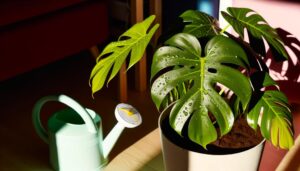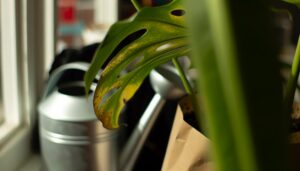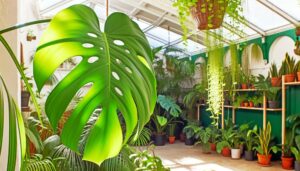Rhaphidophora Tetrasperma and Monstera Minima: Differences!
You might mistake Rhaphidophora tetrasperma and Monstera minima for each other due to their tropical origins and fenestrated leaves. Rhaphidophora tetrasperma features deeply fenestrated, pinnatifid leaves, and a vigorous, vining growth habit.
In contrast, Monstera minima displays smaller, less dissected foliage and grows more compactly. Both thrive in bright, indirect light, yet Rhaphidophora tetrasperma tends to grow vertically while Monstera minima spreads horizontally.
Proper identification hinges on these subtle differences. Adjust soil and watering to match their needs.
If you’re curious about detailed care tips and ideal indoor display ideas, there’s much more to uncover.
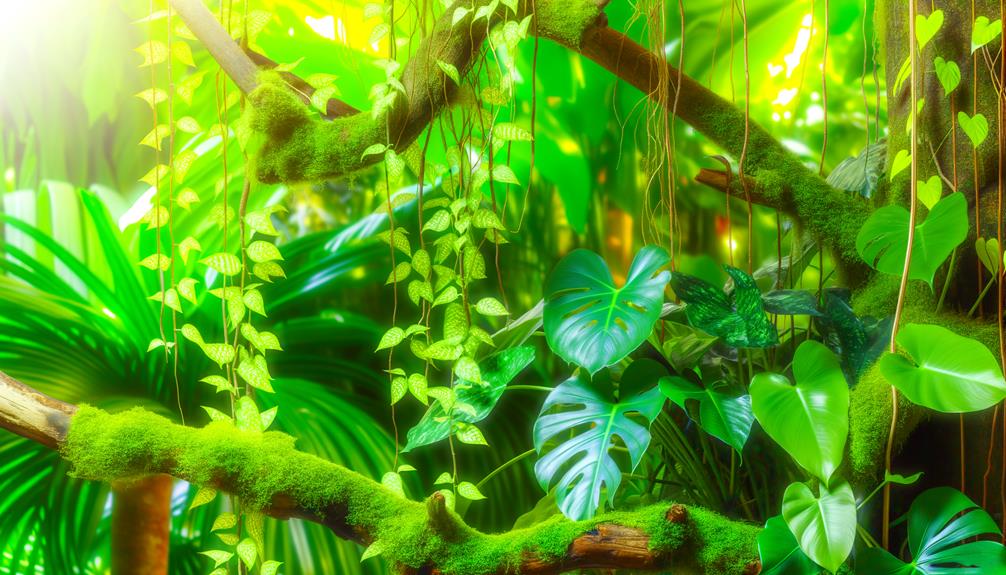
Comparison for Rhaphidophora Tetrasperma and Monstera Minima:
| Characteristic | Rhaphidophora Tetrasperma | Monstera Minima |
|---|---|---|
| Scientific Name | Rhaphidophora tetrasperma | Rhaphidophora tetrasperma |
| Common Name | Mini Monstera, Monstera Minima | Mini Monstera, Monstera Minima |
| Origin | Southern Thailand and Malaysia | Southern Thailand and Malaysia |
| Leaf Appearance | Small, split leaves | Small, split leaves |
| Growth Habit | Climbing, fast-growing | Climbing, fast-growing |
| Light Preference | Bright indirect light | Bright indirect light |
| Water Needs | Moderate, prefer moist soil | Moderate, prefer moist soil |
| Size | Can grow up to 5m in the wild | Can grow up to 5m in the wild |
| Toxicity | Toxic if ingested | Toxic if ingested |
Origins and Background
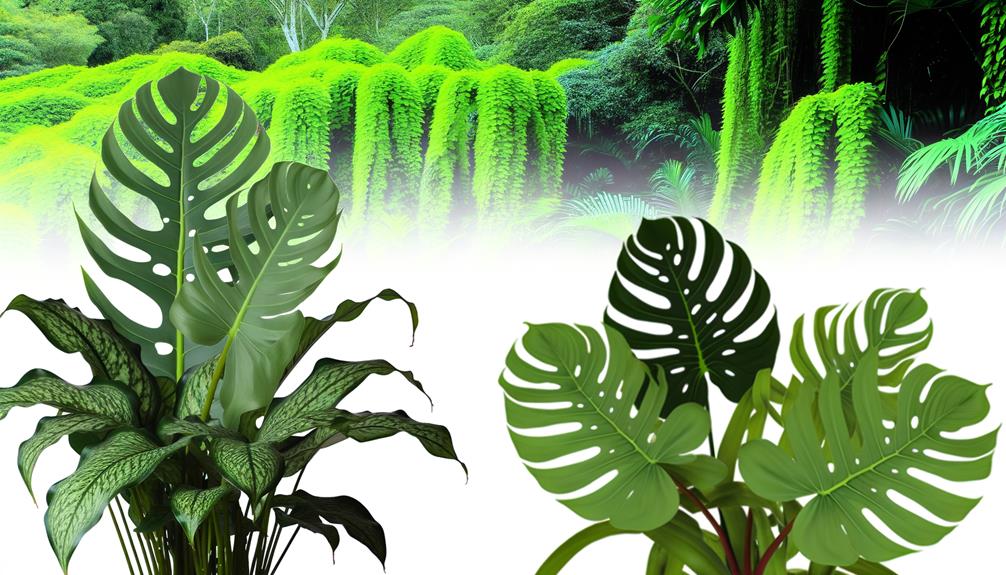
Originating from the tropical regions of Southeast Asia, Rhaphidophora tetrasperma and Monstera minima belong to the Araceae family, showcasing unique fenestrated leaves that have captivated botanists and plant enthusiasts alike.
You’ll find these species in humid, densely forested areas where they thrive under the canopy. Rhaphidophora tetrasperma, often mistaken for Monstera deliciosa, is known for its rapid growth and ability to climb using aerial roots. Monstera minima, though smaller, similarly exhibits climbing tendencies facilitated by its adaptive root structures.
Both species participate in the complex ecological interactions typical of tropical forests, aiding in nutrient cycling and providing habitat for various organisms. Understanding their origins helps in cultivating them successfully in non-native environments.
Appearance Comparison
When comparing Rhaphidophora tetrasperma and Monstera minima, you’ll notice distinct differences in leaf morphology and growth patterns.
Rhaphidophora tetrasperma features deeply fenestrated, pinnatifid leaves, while Monstera minima exhibits smaller, less dissected foliage.
Moreover, Rhaphidophora tetrasperma tends to have a more vining growth habit, contrasting with the more compact and bushy structure of Monstera minima.
Leaf Shape Differences
Despite their similar appearances, the leaf shapes of *Rhaphidophora tetrasperma* and *Monstera minima* exhibit distinct differences that can help in their identification.
You’ll find that Rhaphidophora tetrasperma has more deeply fenestrated leaves, characterized by multiple, irregularly shaped perforations.
In contrast, Monstera minima possesses smaller leaves with fewer perforations, often more symmetrically arranged.
To aid in differentiating these two species, consider the following leaf characteristics:
- Fenestration Depth: *Rhaphidophora tetrasperma* has deeper cuts.
- Perforation Quantity: More numerous in *Rhaphidophora tetrasperma*.
- Symmetry: *Monstera minima* features more symmetrical openings.
- Size: Leaves of *Rhaphidophora tetrasperma* are generally larger.
- Texture: *Monstera minima* leaves feel thicker and more leathery.
Understanding these differences will improve your plant identification skills.
Growth Patterns
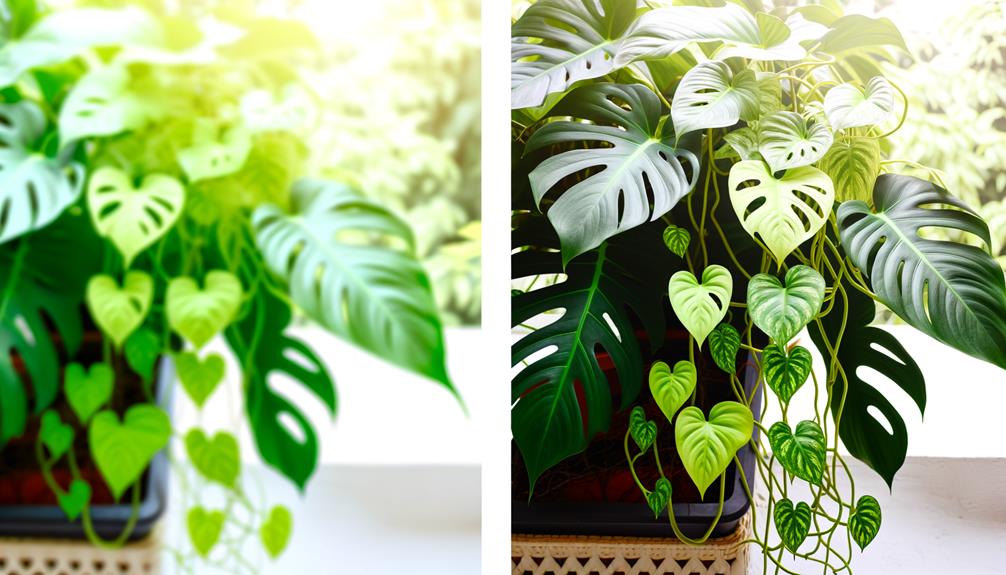
When examining the growth patterns of Rhaphidophora tetrasperma and Monstera minima, you’ll notice distinct climbing and vining tendencies.
Rhaphidophora tetrasperma exhibits rapid, vertical growth with fenestrated leaves, while Monstera minima spreads horizontally with perforated foliage.
Both species thrive in bright, indirect light but exhibit different adaptations to light intensity.
Climbing and Vining Tendencies
Rhaphidophora tetrasperma and Monstera minima exhibit robust climbing and vining tendencies, utilizing their aerial roots and flexible stems to ascend vertical supports efficiently.
You’ll notice these species employ several mechanisms to climb:
- Aerial roots: These roots emerge from nodes, anchoring the plant to surfaces.
- Flexible stems: Their pliable stems twist and turn, seeking structural support.
- Adhesive pads: Some roots develop adhesive pads to cling to surfaces.
- Positive phototropism: They grow towards light, encouraging vertical ascent.
- Epiphytic growth: Often, they grow on other plants, not harming the host.
Leaf Shape Differences
As you observe Rhaphidophora tetrasperma and Monstera minima in their climbing endeavors, the distinct differences in leaf shape and growth patterns become apparent.
Rhaphidophora tetrasperma exhibits pinnatifid leaves with deep, fenestrated lobes that mimic the iconic Monstera deliciosa but on a smaller scale. These leaves grow in an alternate pattern along the stem.
In contrast, Monstera minima, often mistaken for Rhaphidophora tetrasperma, features smaller, less deeply divided leaves with fewer fenestrations. Its leaves emerge in a more symmetrical, opposite arrangement.
Both species exhibit rapid vertical growth, using aerial roots to cling to surfaces. However, the nuanced leaf morphology and growth habits help you distinguish between these two climbers in a botanical setting.
Light Requirements
Curiously, how do the light needs of Rhaphidophora tetrasperma and Monstera minima influence their growth patterns in a controlled environment?
Both species thrive in bright, indirect light, yet they exhibit distinct growth responses. Rhaphidophora tetrasperma, often referred to as the Mini Monstera, prefers dappled sunlight to maintain prime leaf structure.
Conversely, Monstera minima, a common misnomer for Rhaphidophora tetrasperma, demands slightly more filtered light to minimize leaf burn and promote fenestration.
- Leaf Structure: Proper light guarantees characteristic fenestrations.
- Internode Length: Adequate light reduces internode elongation.
- Photosynthesis Rate: Enhanced under optimal lighting conditions.
- Chlorophyll Production: Increased in suitable light environments.
- Overall Growth: Consistent and robust with ideal light exposure.
Understanding these needs aids in achieving vigorous, healthy plants.
Leaf Differences
Often, the leaves of Rhaphidophora tetrasperma are mistaken for those of Monstera deliciosa due to their similar fenestrations, but they exhibit distinct differences in size and shape.
Rhaphidophora tetrasperma, also known as Mini Monstera, has smaller leaves, typically 15-20 cm long, with deep, irregularly shaped splits that can extend to the midrib.
In contrast, Monstera deliciosa leaves can grow up to 90 cm and have more symmetrical, broader lobes with pronounced perforations. Additionally, Rhaphidophora tetrasperma leaves are more delicate and thinner compared to the thicker and more robust leaves of Monstera deliciosa.
Understanding these differences aids in accurate identification and ensures you provide the appropriate care for each species.
Light Requirements

When considering light requirements for Rhaphidophora tetrasperma and Monstera minima, you’ll need to focus on best sunlight exposure and their preference for indirect light. Both species thrive in bright, filtered light but can tolerate lower light conditions, although growth may slow.
To promote healthy development, adjust their light exposure gradually to avoid leaf burn or discoloration.
Optimal Sunlight Exposure
To thrive, Rhaphidophora tetrasperma and Monstera minima require bright, indirect light to mimic the dappled sunlight of their native tropical habitats. Direct sunlight can scorch their delicate leaves, while insufficient light hampers growth and variegation. Position your plants near east or north-facing windows, or use sheer curtains to diffuse stronger light.
- Photosynthetic efficiency: Bright, indirect light optimizes chlorophyll production.
- Leaf morphology: Adequate light maintains fenestration patterns.
- Growth rate: Ensuring ideal light conditions promotes vigorous growth.
- Light duration: Aim for 12-14 hours of light exposure daily.
- Artificial lighting: Supplement natural light with grow lights if needed.
Monitor leaf color and texture to gauge if lighting conditions need adjustment, ensuring your plants remain healthy and vibrant.
Indirect Light Preference
Rhaphidophora tetrasperma and Monstera minima thrive in environments with bright, indirect light, which replicates the filtered sunlight of their tropical rainforest origins. In their native habitat, the dense canopy allows only diffused light to reach the forest floor, creating ideal conditions for these understory plants.
To simulate this in your home, place them near an east or north-facing window, where they’ll receive ample light without direct sun exposure. Direct sunlight can scorch their delicate leaves, causing browning or wilting. Both species possess chlorophyll-rich foliage, which maximizes photosynthesis under lower light levels.
Ensuring bright, indirect light will promote healthy growth, vibrant leaves, and overall vigor. Avoid low light conditions, as these can stunt growth and reduce foliage density.
Light Adaptation Tips
Positioning your Rhaphidophora tetrasperma and Monstera minima near a source of bright, indirect light is crucial for maintaining their health and promoting ideal growth. These epiphytic aroids thrive under specific light conditions that mimic their natural habitat.
- Intensity: Ensure light is bright but diffused, avoiding direct sunlight which can scorch leaves.
- Duration: Aim for 10-12 hours of consistent light daily.
- Orientation: Place plants near east or north-facing windows for best light exposure.
- Artificial Lighting: Use grow lights with a spectrum of 4000-6000K to supplement natural light.
- Signs of Stress: Watch for leggy growth or yellowing leaves as indicators of insufficient light.
Following these guidelines will help your Rhaphidophora tetrasperma and Monstera minima thrive indoors.
Watering Needs
Ensuring proper hydration for Rhaphidophora tetrasperma and Monstera minima involves consistently moist soil without waterlogging, requiring a well-draining potting mix. These species need regular watering; however, you must avoid creating a soggy environment that encourages root rot. Monitor soil dryness by inserting your finger about an inch deep; if it feels dry, it’s time to water.
Using tepid water ensures minimal shock to their roots. During active growth periods, typically spring and summer, increase watering frequency. Conversely, in dormancy phases like winter, reduce the amount while still maintaining slight moisture.
Implementing a consistent watering schedule is essential for these plants’ health, promoting robust foliage and preventing physiological stress.
Soil Preferences
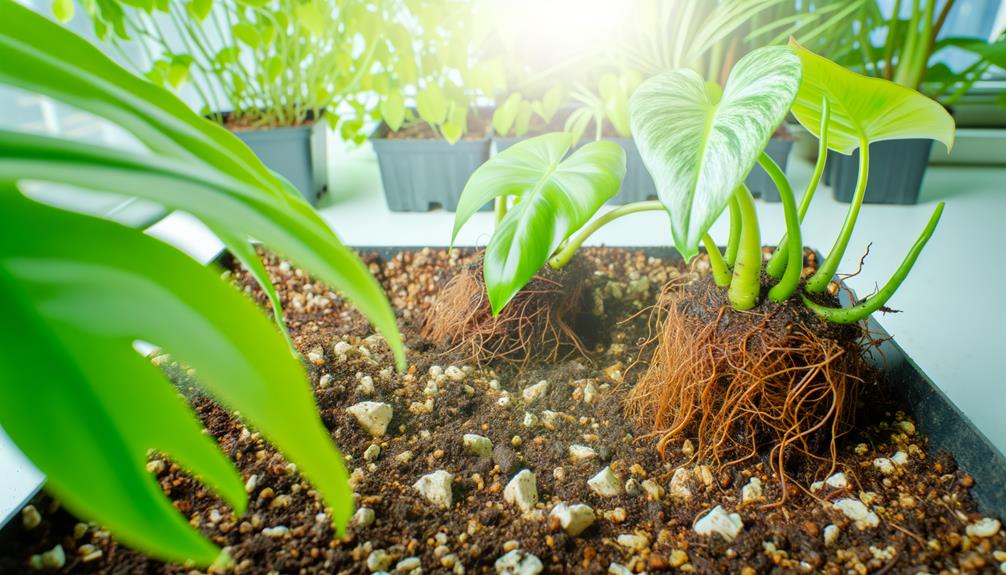
For best growth, Rhaphidophora tetrasperma and Monstera minima thrive in a well-aerated, nutrient-rich potting mix that balances moisture retention and drainage. Achieving the prime substrate involves understanding their natural epiphytic environments.
To create the perfect mix, consider including the following components:
- Orchid bark: Enhances aeration and mimics natural growing conditions.
- Perlite: Improves drainage, preventing root rot.
- Coconut coir: Retains moisture while providing a lightweight texture.
- Activated charcoal: Keeps the soil fresh and reduces harmful pathogens.
- Compost or worm castings: Provides essential nutrients for robust growth.
This blend guarantees the roots receive ample oxygen and nutrients, promoting vigorous development and minimizing the risk of overwatering issues commonly associated with dense, poorly draining soils.
Fertilizing Tips
To promote the lush growth of Rhaphidophora tetrasperma and Monstera minima, regularly apply a balanced, water-soluble fertilizer diluted to half strength during the growing season. This typically spans from spring to early autumn.
Utilize a 20-20-20 NPK (nitrogen, phosphorus, potassium) formulation to guarantee even nutrient distribution. Apply the fertilizer every 4-6 weeks, allowing the soil to dry out slightly between applications to prevent root rot.
Monitor leaf color and growth rate; yellowing leaves might indicate over-fertilization, while slow growth suggests nutrient deficiency. Make sure you water the plants thoroughly before and after feeding to avoid nutrient burn.
This precise regimen will support vigorous growth and healthy foliage, maximizing the ornamental appeal of your Rhaphidophora tetrasperma and Monstera minima.
Common Pests
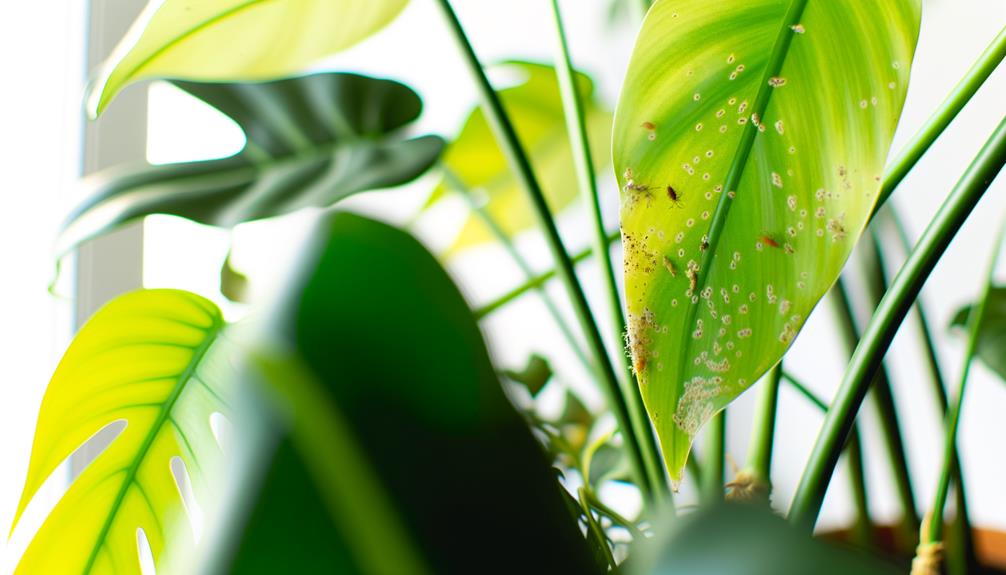
Rhaphidophora tetrasperma and Monstera minima are frequently plagued by common pests such as spider mites, aphids, and mealybugs, which can cause significant damage if not promptly addressed. Spider mites (Tetranychidae) create fine webbing on leaves, leading to discoloration and leaf drop.
Aphids (Aphidoidea) cluster on new growth, sucking sap and excreting honeydew, which attracts mold. Mealybugs (Pseudococcidae) appear as white cottony masses, weakening plants by feeding on sap.
To manage these pests, you should:
- Inspect plants regularly for early detection.
- Isolate affected plants to prevent spread.
- Use neem oil or insecticidal soap for treatment.
- Maintain humidity to discourage spider mites.
- Introduce beneficial insects like ladybugs for natural pest control.
Employing these strategies will help maintain plant health.
Propagation Methods
After confirming that your Rhaphidophora tetrasperma or Monstera minima are pest-free, you can propagate these plants effectively through stem cuttings. Start by selecting a healthy stem with at least one node and aerial root.
Using sterilized scissors, cut just below the node. Place the cutting in water or a well-draining soil mix, making sure the node is submerged or covered. Maintain high humidity levels and indirect light conditions to promote root development.
Change the water regularly to prevent bacterial growth if using the water method. Within a few weeks, you should observe root formation. Once roots are established, shift the cutting to a pot with well-draining soil.
This method guarantees rapid growth and successful propagation.
Indoor Display Ideas
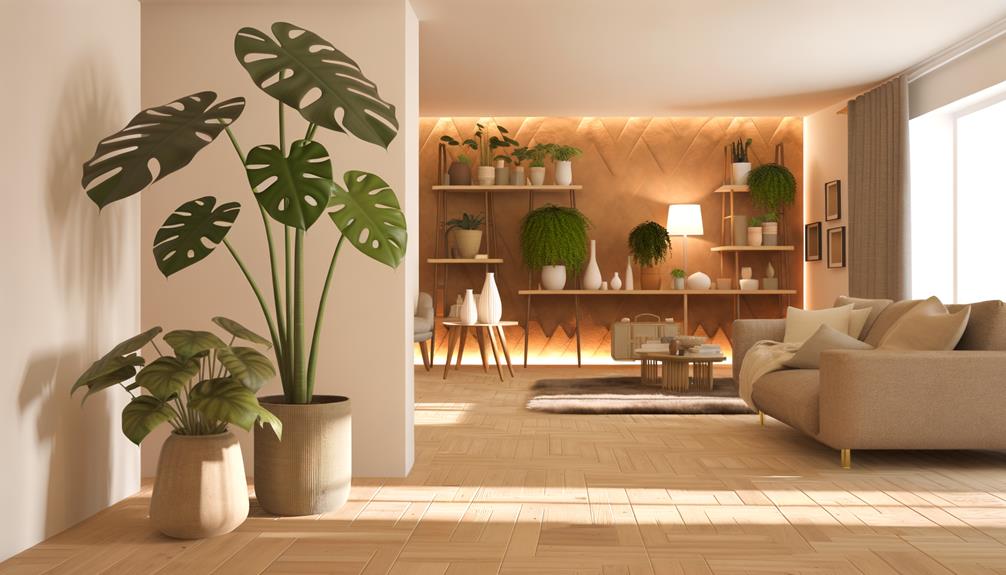
Incorporating Rhaphidophora tetrasperma or Monstera minima into your indoor space can be achieved through various display methods that highlight their unique foliage and climbing nature.
To optimize their growth and aesthetic appeal, consider the following:
- Vertical trellises: Use sturdy supports to guide their climbing habit.
- Hanging baskets: Ideal for showcasing cascading stems and fenestrated leaves.
- Shelf displays: Position on elevated surfaces to let vines trail gracefully.
- Large pots with moss poles: Encourage aerial root development and vertical growth.
- Terrariums: Create a humid microenvironment enhancing leaf pattern visibility.
These methods not only enhance the visual appeal of your indoor garden but also cater to the plants’ natural growth tendencies, ensuring Rhaphidophora tetrasperma and Monstera minima thrive in your care.
Conclusion
To wrap up, Rhaphidophora tetrasperma and Monstera minima are captivating plants that each offer distinct characteristics to your indoor garden. Surprisingly, Rhaphidophora tetrasperma can reach heights of up to 12 feet indoors with ideal care.
By grasping their growth patterns, leaf structure, and particular light and fertilization needs, you can guarantee these plants flourish. Equipped with information on typical pests and efficient propagation techniques, you’re well-prepared to nurture these plant beauties effectively.
Happy growing!

